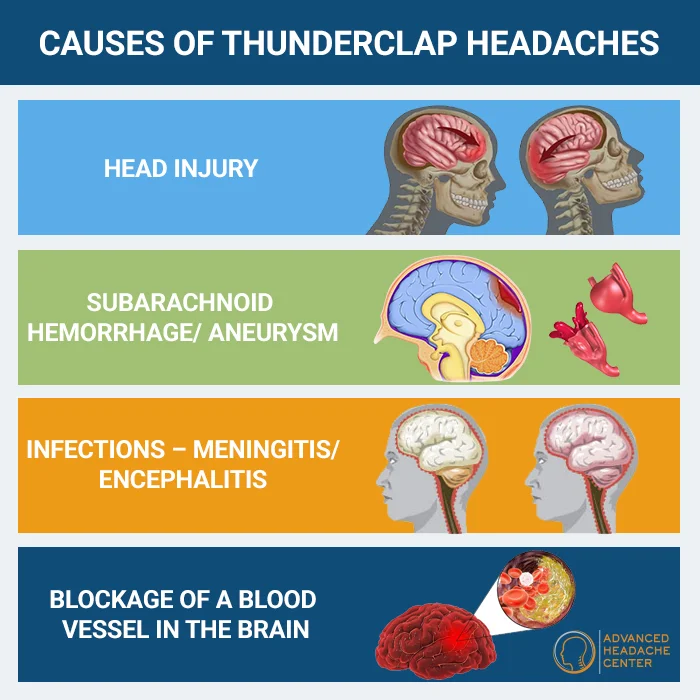Everyone experiences headaches from time to time, so it’s considered normal. But there are certain types of headaches that rarely occur. Although headaches in general are normal, some cases would still require you to seek immediate medical attention. An example of this kind of headache is a thunderclap headache.
So what are thunderclap headaches? Thunderclap headaches come on suddenly and painfully, like a clap of thunder, that peaks within 60 seconds. Approximately 50 out of 100,000 adults suffer from this type of headache each year. Consulting your doctor is important to rule out any underlying medical cause of your thunderclap headache.
Thunder Headache: Understanding Your Sudden Severe Headache
A thunderclap headache (i.e, sentinel headache) is a type of headache that occurs without any kind of warning. Thunderclap headaches are even described by a patient who has had it as a terrible headache, and unlike any other headache that they’ve ever had.
This type of headache disorder is uncommon, but it may be a warning of any potentially detrimental medical condition that needs immediate medical attention such as aneurysmal subarachnoid hemorrhage. More than just a severe headache, a thunderclap headache usually involves bleeding or vasoconstriction that blocks blood flow in and around the brain.
There can be instances that thunderclap headaches are simply headaches, but it’s best to consult with a qualified medical healthcare provider to rule out any possible serious underlying condition to your headache disorder.

What Does a Thunderclap Headache Feel Like: Symptoms of Thunderclap Headache
The following are how thunderclap headache disorders are usually described by a patient who has had it:
- Severe sudden pain in the head, often referred to by a patient who has had it as the worst headache they ever had
- Pain usually peaks within 60 seconds
- Nausea or vomiting may also be experienced along with the extreme pain
Aside from sudden, excruciating pain that lasts for up to 5 minutes and subsides after a few hours, the symptoms of a thunderclap headache may include the following:
- Numbness
- Weakness
- Nausea or Vomiting
- Seizures
- Fever
- Confusion or altered mental state
- Speech problems
- Change in vision
What Causes Thunderclap Headache
All headache disorders may have primary and secondary causes. Although it’s impossible to self-detect which thunderclap headache you’re having based on each symptom experienced, knowing what causes each type is essential to understand why there’s an emphasis on seeking immediate medical assistance when you have thunderclap headaches.
More than just the worst headache, the causes of thunderclap headache disorder are as follows:
- Primary headache. You have a primary thunderclap headache if you didn’t experience any other symptoms other than head pain. This type of thunderclap headache is generally not dangerous because there isn’t any serious underlying health issue that causes the pain. These thunderclap headaches may be idiopathic thunderclap headache which occurs due to any triggers of primary thunderclap headache, or they can also be postcoital thunderclap headaches which occur after sexual activity.
- Secondary headache. This thunderclap headache usually warns you of a possible undetected life-threatening health issue. Blood vessel issues in your brain (i.e, brain aneurysm, vasoconstriction), along with other symptoms, are the usual causes of a secondary thunderclap headache.
Other Triggers of Thunderclap Headaches
Primary thunderclap headaches are generally unalarming, and it may be triggered by certain activities such as the following:
- Sexual activity
- Hard physical labor
- Drug intake
- Hitting warm water suddenly
Secondary thunderclap headaches, on the other hand, require you to have yourself checked for any potentially detrimental medical condition.
As such, secondary thunderclap headaches aren’t simply caused by mild issues in your brain, some of the other triggers for it are:
- Leaking cerebrospinal fluid
- Blocked veins in your head
- Brain infection
- Blood clot or plaque
- Narrowed blood vessels around the brain
- Inflamed blood vessels
- Small tears in the arteries (it may be in your head or neck)
The underlying conditions that you may have that causes secondary thunderclap headaches are the following:
- Subarachnoid hemorrhage. Subarachnoid hemorrhage is the most common cause of secondary thunderclap headaches, which are characterized as bleeding in and around the area of the brain.
- Reversible cerebral vasoconstriction syndrome. The second most common cause, of this condition is the sudden constriction of the blood vessels that supply blood to your brain.
- Stroke. A blocked or bleeding blood vessel involved in the condition of a stroke may also trigger a thunderclap headache.
- Brain aneurysm. Aneurysm is a condition wherein there is bulging or bleeding of a blood vessel in the brain, which can trigger a secondary thunderclap headache.
- Head injury and sudden extreme increase in blood pressure. Secondary thunderclap headaches can occur as a result of an injury to the brain or a severe rise in blood pressure that causes a brain bleed and other damage to the blood vessels in the brain.
- Pituitary apoplexy. Disrupted or blocked blood flow or bleeding in your pituitary gland may also cause a secondary thunderclap headache.
- Pregnancy complications. There is a possibility of complications during late-term pregnancy or shortly after delivery, such as high blood pressure and bleeding in your pituitary gland during pregnancy.
- Cerebral venous sinus thrombosis. When a blood clot forms in the brain’s venous sinuses, blood cannot drain out of the brain, which causes cerebral venous thrombosis.
- Spontaneous intracranial hypotension. Several sites in the dural membrane may leak cerebrospinal fluid, causing this condition. As a result of the loss of cerebrospinal fluid, cerebral structures are displaced, resulting in the secondary thunderclap headache.
- Cervical artery dissection. When you have a tear in the wall of a large blood vessel (i.e, artery) in your neck, then you may experience irregularities in blood flow, that would cause a secondary thunderclap headache from your cervical artery dissection.
- Intracranial hypotension. A symptom of intracranial hypotension may be the abnormally low pressure or volume within the skull. Additionally, this condition is caused by a reduction in cerebrospinal fluid.
Additionally, secondary thunderclap headaches may also be indicative of pheochromocytoma and carcinoid tumors. The extent of the underlying conditions that you may have when you experience thunderclap headaches are something that you shouldn’t simply ignore, which is why it’s important to seek medical assistance for this type of headache.
How Long Do Thunderclap Headaches Last
Thunderclap headaches are characterized as a sudden, intensely painful type of headache that usually peaks within 60 seconds, but lasts for at least 5 minutes, and gradually fades within the next couple of hours. Additionally, primary thunderclap headache may intermittently recur for several years.
How Thunderclap Headaches Differ from Migraines and Ice Pick Headache
Thunderclap headaches are characterized as a sudden headache that’s intensely painful, so other people may sometimes confuse it with migraine headache and ice pick headache. But it’s important to note that thunderclap headache is a different kind of headache than the others mentioned.
The headache disorders aforementioned aren’t generally indicative of a serious medical condition, while thunderclap headaches are usually a warning sign of an underlying health issue that needs immediate medical attention.
| Thunderclap Headaches | Migraines | Ice Pick Headaches | |
| Symptom/s | Sudden intense pain | Intense Pain | Sudden stabbing Pain, multiple bursts of pain |
| Duration | 5 minutes | 4 to 72 hours | Few seconds |
| Is it indicative of a severe underlying condition? | Most of the time | Not always | Rarely |
When Thunderclap Headache Becomes a Medical Emergency
It’s impossible to know for sure what kind of thunderclap headache you have unless it’s diagnosed by a qualified medical professional. This means that a thunderclap headache will always be a medical emergency that you need to consult with your healthcare provider.
As stated by the American Migraine Foundation, when you experience a thunderclap headache for the first time, go to the emergency room immediately. Identifying the underlying cause is essential so that it can be treated promptly if necessary. In some cases, thunderclap headaches can be fatal if not treated promptly.
A sentinel headache is usually a symptom that precedes subarachnoid hemorrhage. Even if that condition is ruled out, there are still other conditions that you must be cleared of before your thunderclap headache becomes a primary thunderclap headache. So thunderclap headaches will always be a headache disorder that requires immediate medical attention.
Diagnosis of Thunderclap Headache
The first step to treating your thunderclap headache disorder is finding what causes it. All possible life-threatening underlying conditions must be ruled out or identified first before creating a treatment plan that’s specifically tailored to your thunderclap headache.
Before your healthcare provider runs through some tests to rule out any underlying condition that you may have, the following questions will be asked first for diagnosis:
- Did you experience other headache disorders such as this?
- Did you experience other headache disorders before?
- Did your past headache disorders occur continuously or occasionally?
- How severe were the headache disorders you experienced?
- How did you remediate your previous headaches?
You will also be asked to describe your headache, along with each symptom you experienced, and if there was anything that made it worse. After that, any severe underlying condition will be ruled out or identified before an appropriate treatment plan may be prescribed to you.
Some tests that may be performed are the following:
- CT Scan
- Lumbar Puncture
- CT Angiography
First, a CT scan is performed to rule out subarachnoid hemorrhage. If no apparent diagnosis is shown, then a lumbar puncture will be performed after the CT scan.
Thunderclap headache disorders will always be considered as coming from secondary causes until all possible life-threatening medical conditions are ruled out. After thorough and accurate diagnostic work and every potential medical cause has been excluded, then that’s the only time when a primary thunderclap headache can be the final diagnosis.
Thunderclap Headache Treatments
Prompt response to your thunderclap headache disorder through accurate diagnosis of what causes it is important to address any serious underlying brain disorders that are commonly causing this kind of headache.
There are cases when a thunderclap headache treatment involves surgery because it is associated with an urgent underlying condition, but there are also cases when only medication is prescribed to treat a thunderclap headache.
1) Medication
Thunderclap headaches can be treated with medication if they aren’t caused by an urgent underlying condition (i.e. primary thunderclap headaches). Swelling can be reduced with nonsteroidal anti-inflammatory drugs (NSAIDs).
Certain medications may induce the narrowing of brain arteries, and if you know what causes thunderclap headaches then you’d likely acknowledge the fact that this may worsen the situation.
These medications that shouldn’t be used to treat thunderclap headaches are:
- Glucocorticoids
- Triptans
- Other anti-migraine medications
2) Surgery
Conditions that usually cause secondary thunderclap headaches require surgery to effectively facilitate and promote proper blood flow in and around the vein. Surgery may be extremely necessary to repair damaged blood vessels, or anything that needs to be remediated to fix an underlying condition immediately.
Comprehensive Headache Treatments at Advanced Headache Center
Thunderclap headaches come on without a warning, causing severe pain that peaks within 60 seconds and lasts up to 5 minutes. These headaches are different to prevent, but avoiding triggers, and maintaining a healthy active lifestyle to stabilize your blood pressure can help reduce the risk of a secondary thunderclap headache.
Here at Advanced Headache Center, Dr. Hosny expertly diagnoses the causes of thunderclap headache disorders and recommends the best treatment plan for them. Our headache center also provides treatments for other headache disorders such as a migraine ache or even ice pick headaches.
For the best treatment in the New York City and northern New Jersey areas, contact us today.




